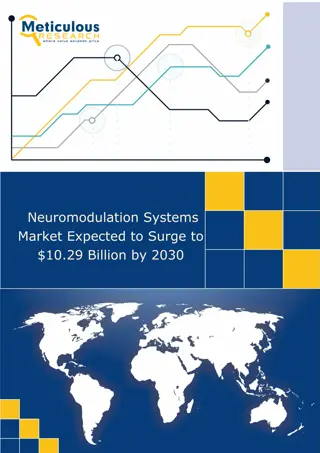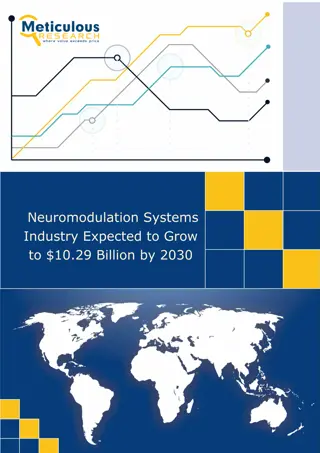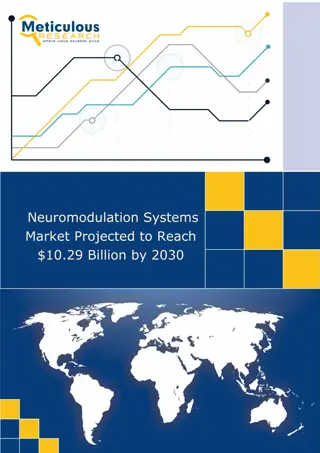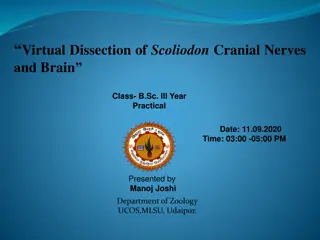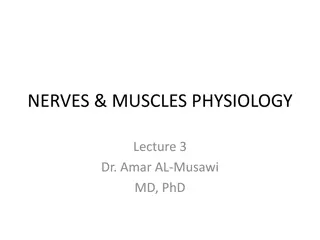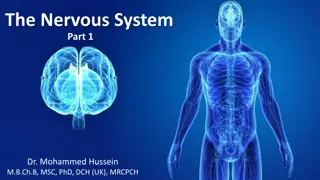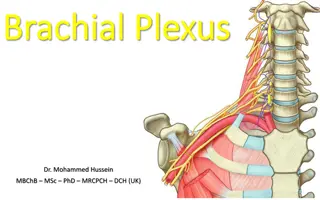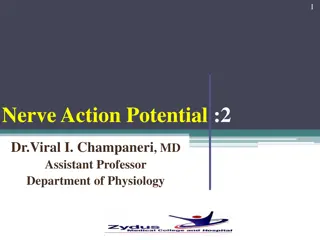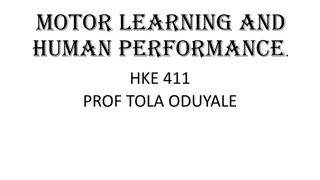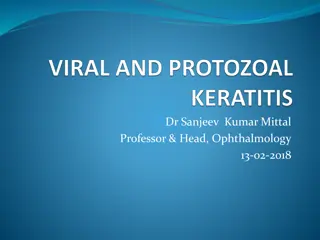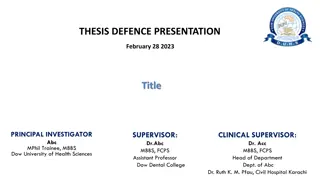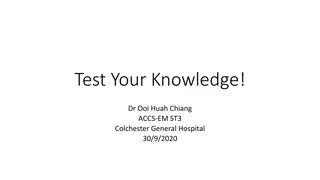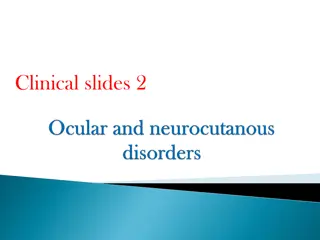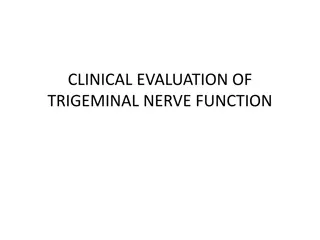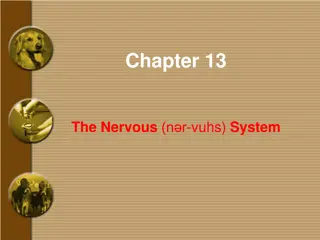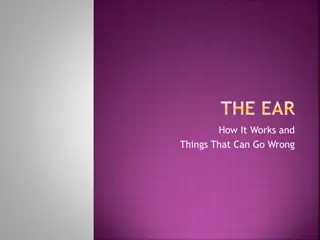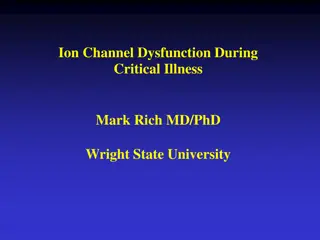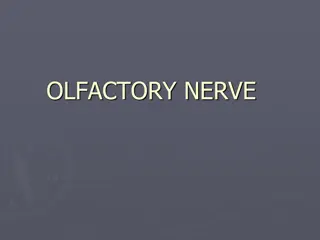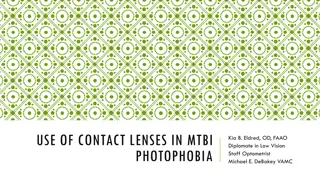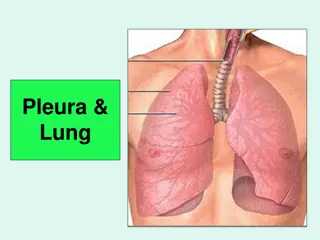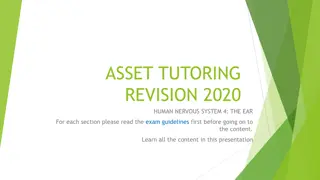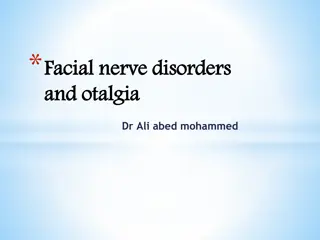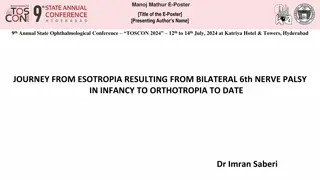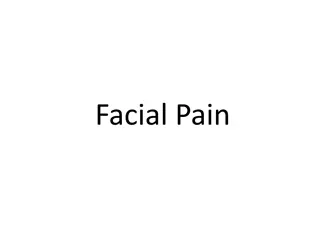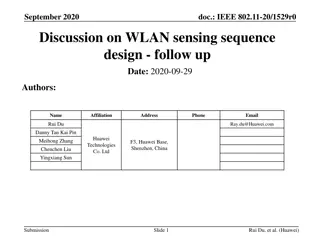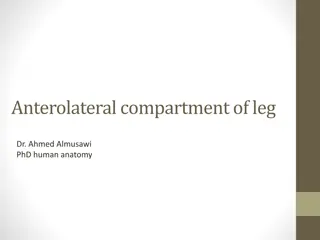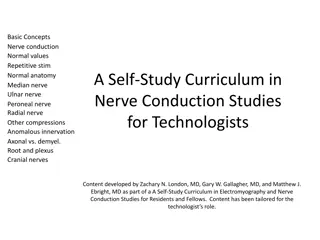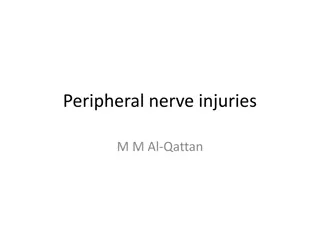The Popliteal Fossa
The popliteal fossa, a shallow depression at the back of the knee joint that serves as a passage for main vessels and nerves. Discover its boundaries, roof, floor, and contents like the popliteal artery, popliteal vein, tibial nerve, and common fibular nerve.
3 views • 9 slides
SMALL FIBRE
Small fiber neuropathy involves thin and unmyelinated nerve fibers, leading to various sensory disturbances. The Erlanger and Gasser classification details the different types of nerve fibers involved. Symptoms include burning, tingling, and numbness, often presenting in a stocking-glove pattern. Di
4 views • 53 slides
Nerve and muscle physiology
The lecture delves into the intricate structure of nerves, highlighting the morphology of nerve fibers and the process of myelination. It explores the classification of nerve fibers, emphasizing the role of dendrites, axons, and synaptic functions in the nervous system. The significance of Schwann c
4 views • 29 slides
Neuromodulation Systems Market Expected to Surge to $10.29 Billion by 2030
Meticulous Research\u00ae\u2014a leading global market research company, published a research report titled\n \u2018Neuromodulation Systems Market by Type (Spinal Cord, Sacral Nerve, Vagus Nerve, Deep Brain Stimulation),\n Application (Parkinson's Disease, Tremor, Depression, Epilepsy, Gastroparesis
0 views • 3 slides
Neuromodulation Systems Industry Expected to Grow to $10.29 Billion by 2030
Meticulous Research\u00ae\u2014a leading global market research company, published a research report titled\n \u2018Neuromodulation Systems Market by Type (Spinal Cord, Sacral Nerve, Vagus Nerve, Deep Brain Stimulation),\n Application (Parkinson's Disease, Tremor, Depression, Epilepsy, Gastroparesis
0 views • 3 slides
Neuromodulation Systems Market Projected to Reach $10.29 Billion by 2030
Meticulous Research\u00ae\u2014a leading global market research company, published a research report titled \n\u2018Neuromodulation Systems Market by Type (Spinal Cord, Sacral Nerve, Vagus Nerve, Deep Brain Stimulation), \nApplication (Parkinson's Disease, Tremor, Depression, Epilepsy, Gastroparesis
1 views • 3 slides
Virtual Dissection of Scoliodon Cranial Nerves and Brain: A Detailed Practical Guide
Explore the virtual dissection of Scoliodon's cranial nerves and brain in this informative practical session for B.Sc. III Year students. Learn about the anatomy and innervations of various nerves like Olfactory, Optic, Trigeminal, Facial, and more. Discover the phylum, group, and class of Scoliodon
0 views • 9 slides
Understanding Renal Function Tests and Kidney Health
Renal function tests are essential for diagnosing and monitoring kidney health. These tests assess functions like glomerular filtration, tubular reabsorption, and endocrine functions of the kidneys. Common indicators include serum urea, creatinine levels, and more. It's crucial to evaluate renal fun
0 views • 34 slides
Understanding Nerves and Muscles: Physiology Insights by Dr. Amar AL-Musawi MD, PhD
Explore the intricate world of nerve fiber morphology, myelination, and classification in this enlightening lecture by Dr. Amar AL-Musawi. Delve into the significance of myelination in enhancing nerve function and learn about factors affecting conduction velocity. Discover the role of glial cells in
0 views • 15 slides
Understanding the Basics of the Nervous System with Dr. Mohammed Hussein
Explore the fundamentals of the nervous system in Part 1 with Dr. Mohammed Hussein, covering nerve cells, cellular processes, types of neurons, nerve structure, blood vessels, grey matter, and afferent and efferent neurons. Gain insights into the key components that make up this intricate system.
0 views • 12 slides
Understanding the Brachial Plexus Anatomy and Function
The brachial plexus is a crucial network of nerves in the upper limb, formed by nerve fibers originating from C5 to T1 spinal levels. It plays a significant role in innervating the upper extremity muscles and providing sensory feedback. The plexus is categorized into roots, trunks, divisions, cords,
0 views • 55 slides
Mechanism of General Anaesthesia Theories: Lipid Solubility, Surface Tension, Microcrystal, Protein Binding
Mechanism of general anaesthesia involves theories focusing on the interaction of anaesthetics with cell membrane components like lipids and proteins. The Lipid Solubility theory emphasizes the importance of an anaesthetic's affinity and solubility in nerve cell membranes, while the Surface Tension
1 views • 10 slides
Understanding Nerve Action Potentials: Key Stages and Mechanisms
Explore the intricate process of nerve action potentials, including depolarization, overshoot variations, repolarization stages, and the role of ion levels. Delve into the details of how neurons generate and propagate electrical signals essential for communication in the nervous system.
1 views • 63 slides
Leprosy Nerve Examination by Dr. N. K. Kansal
This informative content provides a detailed guide on leprosy nerve examination conducted by Dr. N. K. Kansal, an Associate Professor. It covers the procedure for palpation of a nerve, emphasizing correct patient positioning and gentle palpation techniques. The importance of comparing nerves on both
0 views • 16 slides
Introduction to Gamma Function and Equivalent Integral Forms
The Gamma function is a versatile mathematical function that generalizes the factorial function to non-integer and complex values. It has various integral definitions such as the Euler-integral form. The proof of the factorial property of the Gamma function is demonstrated through analytical continu
1 views • 20 slides
Understanding the Biological Basis of Human Motion and Motor Learning
In the biological basis of human motion, a series of electro-chemical-physical reactions occur at the neuromuscular junction, enabling nerve stimulation for muscle contraction. Nerve impulses for movement originate in the central nervous system or muscles, with acetylcholine transmitting impulses be
0 views • 13 slides
Understanding Ocular Herpes Virus: Pathogenesis, Mechanism of Action, and Clinical Features
Herpes viruses are common human pathogens causing both asymptomatic infection and active disease. Ocular herpes, typically caused by HSV-1, presents with symptoms like pain, photophobia, and blurred vision. Factors like UV rays, trauma, and stress can trigger reactivation. Recurrent infections often
2 views • 33 slides
Study on Work-Related Musculoskeletal Disorders and Median Nerve Entrapment in Upper Limb
Investigating the prevalence, factors, and treatment options for work-related musculoskeletal disorders, focusing on median nerve entrapment in the upper limb. The study aims to provide insights into this condition through a thorough literature review and research objectives.
1 views • 31 slides
Understanding Facial Nerve Lesions: Clinical Scenarios and Anatomy Overview
A comprehensive exploration of facial nerve lesions through real-life clinical scenarios and detailed anatomical insights. Dive into cases involving trauma, fractures, and abscesses to understand the varied manifestations of these lesions. Learn about the functions of the facial nerve, its segments,
0 views • 22 slides
Understanding Neurological Conditions: Clinical Slides and Symptoms
This presentation covers various neurological conditions including oculomotor nerve palsy, Horner's syndrome, and shingles caused by the varicella-zoster virus. It explains the symptoms, causes, and characteristics of these conditions with accompanying clinical slides. Learn about the signs and symp
0 views • 24 slides
Clinical Evaluation of Trigeminal Nerve Function
Sensory evaluation of trigeminal nerve function involves assessing exteroceptive sensations across its divisions, identifying sensory losses due to lesions, and distinguishing different types of lesions affecting sensation on the face. Motor evaluation focuses on the muscles of mastication to detect
0 views • 34 slides
Understanding Local Anesthesia and Nerve Conduction Blockade
Local Anesthetics (LAs) are drugs that abolish sensations like pain in specific body areas by blocking nerve conduction of sensory impulses. This process involves reducing the influx of sodium ions, preventing membrane depolarization, and inhibiting action potential conduction. LAs are weak bases wi
0 views • 22 slides
Understanding the Nervous System: A Comprehensive Overview
The nervous system consists of the central nervous system (CNS) and peripheral nervous system (PNS), with neurons as its basic unit. Neurons function as sensory, associative, and motor types, carrying impulses within the body. Parts of a neuron include the cell body, dendrites, axon, and terminal en
1 views • 86 slides
Understanding How the Ear Works and Common Issues
The ear functions for hearing and balance, with the cochlea for hearing and semicircular canals for balance. Sound waves are funneled through the pinna, vibrate the eardrum, pass through the ossicles, and move fluid in the inner ear to transmit nerve impulses. Important terms include auditory cortex
0 views • 19 slides
Understanding Ion Channel Dysfunction in Critical Illness
An intriguing case study presents a young male with weakness and coma in the ICU following pneumonia and sepsis. Nerve conduction results indicated critical illness myopathy and polyneuropathy, along with cardiac abnormalities. Reduced muscle excitability was attributed to a sodium channelopathy. Th
0 views • 14 slides
Understanding Animal Tissues: Epithelial, Muscle, Nerve, and Connective Tissues
Explore the four general categories of animal tissue - epithelial, muscle, nerve, and connective tissues. Learn about the traits, classification, examples, and functions of each type of tissue. From the tightly packed cells of epithelial tissue to the excitable nature of muscle tissue, delve into th
1 views • 22 slides
Exploring the Olfactory Nerve and Its Role in the Sense of Smell
The olfactory nerve, the first cranial nerve, plays a crucial role in our sense of smell. It is unique for its ability to regenerate, with basal cells facilitating this process. The olfactory system is responsible for detecting odors and is essential for various behaviors in mammals. This system con
0 views • 20 slides
Overview of Graphing Techniques and Functions
Explore graphing techniques including stretching, shrinking, reflecting, symmetry, translations, and various types of functions such as the identity function, square function, cube function, square root function, cube root function, and absolute value function. Understand vertical and horizontal shi
0 views • 25 slides
Monitoring Thyroid Function After Head and Neck Cancer Treatment
This collection of images and data discusses the importance of monitoring thyroid function after head and neck cancer treatment, specifically focusing on post-treatment thyroid function tests, audits of practices in head and neck units, thyroid function post laryngectomy, and the significance of det
0 views • 11 slides
Understanding the Use of Contact Lenses in Photophobia Associated with mTBI
Photophobia in patients with mild traumatic brain injury (mTBI) can be debilitating, with up to 59% of military personnel reporting sensitivity to light after a TBI event. Contact lenses, sunfilters, and tinted glasses can help manage photophobia symptoms. Mechanisms underlying photophobia involve t
0 views • 10 slides
Understanding Pleura and Lung Anatomy
Pleura is a double-layered serous membrane surrounding the lungs, consisting of parietal and visceral layers. The pleural cavity between them contains pleural fluid. Parietal pleura is subdivided into cervical, costal, mediastinal, and diaphragmatic regions. The pleura has nerve supply that makes it
0 views • 31 slides
Understanding the Human Ear: Structure, Function, and Adaptations
Explore the intricate structure of the human ear, its role in hearing, and adaptations for sound absorption. Learn about the functions of different ear parts, from the pinna to the auditory nerve, in converting sound waves into nerve impulses for interpretation by the brain.
0 views • 14 slides
Understanding Gray Matter in the Brain: Structure, Function, and Importance
Gray matter in the brain plays a crucial role in information processing and cognitive functions. Composed of neuronal cell bodies and unmyelinated axons, gray matter is visibly pinkish-gray and is essential for various brain functions. It forms a synaptically dense area with fewer cell bodies compar
0 views • 7 slides
Understanding Facial Nerve Disorders: An Overview
Facial nerve disorders can lead to various symptoms such as facial paralysis and otalgia. This article covers the embryology, anatomy, and neuropathophysiology of the facial nerve. The development of the facial nerve complex occurs in the early stages of gestation, and abnormalities may be associate
0 views • 39 slides
Journey from Esotropia Resulting from Bilateral 6th Nerve Palsy in Infancy to Orthotropia
A detailed case study presented at the 9th Annual State Ophthalmological Conference showcases the successful management of esotropia resulting from bilateral 6th nerve palsy. The journey of a 30-year-old male patient from childhood inward eye deviation to achieving orthotropia post-surgical interven
0 views • 6 slides
Understanding Trigeminal Neuralgia: Symptoms, Diagnosis, and Treatment Options
Trigeminal neuralgia, also known as "tic douloureux," is characterized by sudden, sharp facial pain that can be triggered by various factors. It predominantly affects middle-aged and elderly women. Diagnosis involves recognizing distinct pain patterns and ruling out other causes of facial pain. Trea
0 views • 15 slides
Analysis of WLAN Sensing Sequence Design Using Ambiguity Function and Range-Doppler Map
In this document, the authors from Huawei discuss the analysis of employing the ambiguity function for WLAN sensing sequence design. They delve into the ambiguity function's definition, analysis, and its comparison with the range-Doppler map. The document highlights the importance of ambiguity funct
0 views • 15 slides
Overview of Leg Compartments and Nerve Supply in Human Anatomy
This informative content provides detailed insights into the anterolateral compartment of the leg, facial compartments, muscles in the lateral compartment, nerve supply, anterior compartment of the leg, blood, and nerve supply, deep fibular nerve distribution, dorsum and dorsalis pedis artery. It di
0 views • 10 slides
Understanding Electrical Concepts in Nerve Conduction Studies
Exploring the fundamental electrical properties in nerve conduction studies, including charge, voltage, current, and impedance. Learn about normal values, anatomy, and anomalies in nerve function. This self-study curriculum is designed for technologists interested in electromyography and nerve condu
0 views • 73 slides
Overview of Peripheral Nerve Injuries and Brachial Plexus Injuries
Explore different types of peripheral nerve injuries including Erb's palsy, Klumpke palsy, isolated axillary nerve injury, and isolated musculocutaneous nerve injury. Learn about the anatomy, causes, motor and sensory exams, and management of these injuries. Understand the myotomes and dermatomes as
0 views • 19 slides



